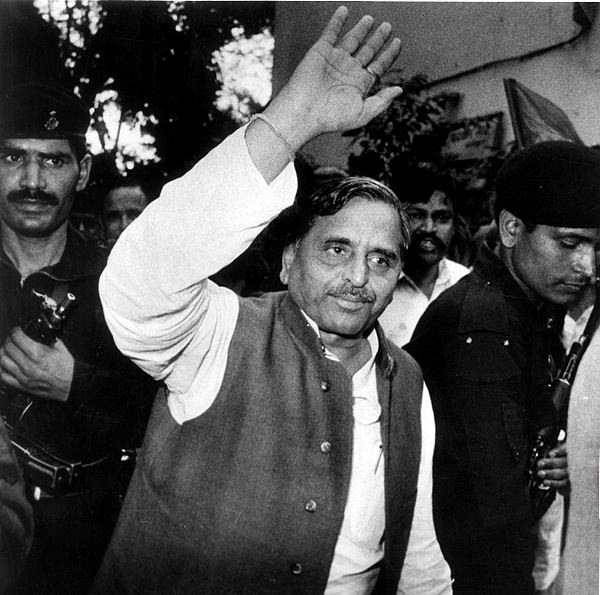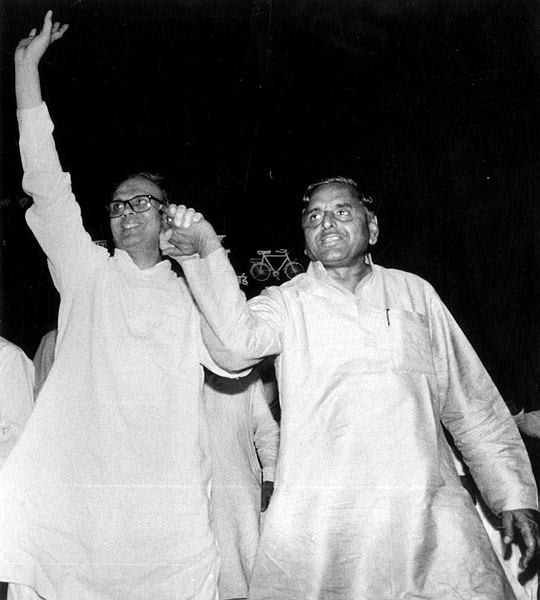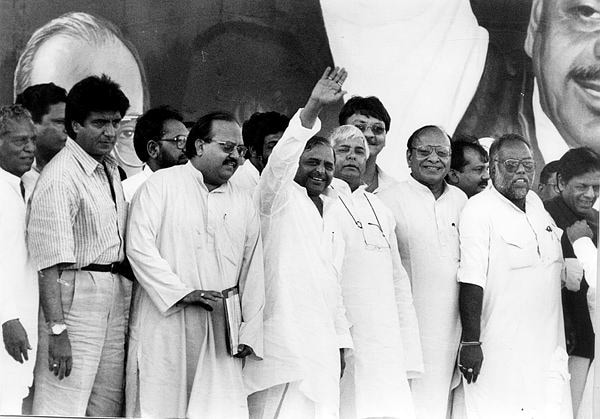If the first generation of leaders of Uttar Pradesh — as indeed of other parts of the country — were freedom fighters; the second generation — which emerged from the late sixties onward — were street fighters. Many of these leaders were socialists who cut their political teeth on campuses, fought vigorously for people’s causes, and acquired stature during and after the Emergency.
Mulayam Singh Yadav was the tallest and most prominent leader of this generation — a man who set new rules and benchmarks for political action in UP and, to a significant extent, other parts of North India as well. His passing marks the end of an era.

1. Assertion of farming communities
Ram Manohar Lohia rallied farming communities — many of whom would later comprise the Other Backward Classes (OBCs) — with the slogan, “Sansopa ne baandhi gaanth, pichhde paawein sau mein saath (The Samyukt Socialist Party has taken this resolve, OBCs should get 60% of all)”. After Lohia — who passed away in October 1967, soon after Mulayam Singh Yadav becoming MLA for the first time — the Jat leader Charan Singh consolidated the OBCs. Most of these groups rallied behind V P Singh after he quit the Congress, which was not willing to accommodate their aspirations.
With the coming to power of Mulayam Singh Yadav on December 5, 1989 began a long period in the politics of UP during which upper castes were kept away from power. This phase — unbroken except for short periods in 1999-2000 and 2000-2002 when Ram Prakash Gupta and Rajnath Singh became CMs — ended only with the coming to power of Yogi Adityanath, a Thakur, in 2017.
It was under Mulayam that the post-Mandal 27 per cent reservation for OBCs was implemented — triggering social churn that nudged the BJP to project Kalyan Singh, an OBC leader, as CM in 1991. While the biggest share of the spoils of political power under Mulayam went to Yadavs, the representation of OBCs in government improved overall; significantly, several OBC communities who did not use their surnames in previous decades now began to feel confident enough to do so.
 Samajwadi party chief Mulayam Singh Yadav. (Express archive photo by Mohan Bane 7.12.1995)
Samajwadi party chief Mulayam Singh Yadav. (Express archive photo by Mohan Bane 7.12.1995)
2. Entry of Dalits in corridors of power
Story continues below this ad
In 1977, when Ram Naresh Yadav became the first non-upper caste CM of UP, a prominent contender for the job was the Dalit leader Ram Dhan. But it was the emergence of Mulayam and his politics of social justice that for the first time allowed Dalits to get a foot in the door — a significant fact that is often obscured by the narrative of rivalry between the SP and Kanshi Ram’s BSP.
In the 1993 Assembly polls, which were held after the demolition of the Babri Masjid, the BJP’s hopes of gaining from a Hindu consolidation were scuttled by Mulayam, who allied with the BSP, a party that was considered a small player until then. The SP-BSP government, however, did not last — Mulayam had his own style of politics, and the BSP was impatient for power. The contradictions in the alliance led to Mayawati becoming the first Dalit Chief Minister of UP in June 1995, supported, ironically enough, by the BJP.
The BSP gained in strength thereafter, and Mayawati was able to form a government on her own in 2007, which lasted a full five years. She is the longest serving CM of UP so far, while second is Mulayam Singh Yadav himself. The SP and BSP did get back together in the 2019 Lok Sabha elections, in which the BSP won 10 seats. The politics of both parties are at a crossroads now — and the BJP has employed a formula of social engineering that can no longer be countered by formulae such as “M+Y” that paid dividends in earlier periods.
 Samajwadi party Chief Mulayam Singh Yadav with VP Singh. (Express archive photo by Vinayaka Prabhu)
Samajwadi party Chief Mulayam Singh Yadav with VP Singh. (Express archive photo by Vinayaka Prabhu)
3. Even before BJP, a Congress-mukt UP
Story continues below this ad
The day Mulayam first took oath in 1989 was the Congress’s last day in power in UP. Before 1989, Muslims and Dalits were seen as the Congress’s base, besides most of the upper castes — Mulayam broke through this social alliance with his politics of social justice, delivering a blow from which the Congress could never recover. The slogan of “Congress-mukt Bharat” given by Narendra Modi and Amit Shah prior to the Lok Sabha elections of 2014 was in a way realised by Mulayam in UP a quarter century previously.
4. Among the tallest leaders of Muslims
A large section of the Muslim vote moved to Charan Singh when he defected from the Congress and went on to become Chief Minister twice and, for a short time, Prime Minister of India.
Muslims later moved to V P Singh’s Janata Dal and, in later years appeared to gravitate towards any party that was considered capable of defeating the BJP.
 Raj Babbar, Amar Singh, Mulayam Singh Yadav, Laloo Prasad Yadav, Shankar Singh Waghela and others during a public meeting. (Express archive photo by Mohan Bane 13.9.1998)
Raj Babbar, Amar Singh, Mulayam Singh Yadav, Laloo Prasad Yadav, Shankar Singh Waghela and others during a public meeting. (Express archive photo by Mohan Bane 13.9.1998)
In UP, the chief beneficiary was Mulayam — who relied on a Muslim-Yadav coalition as his core constituency. This support has stood the test of time, as the vote percentage of the SP under Akhilesh Yadav in this year’s Assembly polls showed. With the SP out of power until at least 2027, however, it remains to be seen what percentage of the Muslim vote remains loyal to the party Mulayam founded.
5. The politics of dynasty and strongmen
Story continues below this ad
The rapid criminalisation of politics in UP began during the Emergency, under leaders such as H N Bahuguna and N D Tiwari, patronised by Sanjay Gandhi. This trend continued during the Janata rule of 1977-80. The government of Chief Minister V P Singh, which came to power in June 1980, saw multiple encounter killings of criminals and dacoits, allegedly of certain castes.
The trend of criminal elements finding refuge in politics strengthened under Mulayam, who repeatedly faced allegations of protecting and promoting these elements. While he was not the only politician to be accused thus, it did leave a stain on the SP’s reputation.
The other allegation Mulayam faced was of establishing his family in his party and in the politics of Uttar Pradesh — indeed, there was a time when 10 members of his family held important political positions. Akhilesh has been trying hard to rid the SP of this reputation as well.



 Samajwadi party chief Mulayam Singh Yadav. (Express archive photo by Mohan Bane 7.12.1995)
Samajwadi party chief Mulayam Singh Yadav. (Express archive photo by Mohan Bane 7.12.1995) Samajwadi party Chief Mulayam Singh Yadav with VP Singh. (Express archive photo by Vinayaka Prabhu)
Samajwadi party Chief Mulayam Singh Yadav with VP Singh. (Express archive photo by Vinayaka Prabhu) Raj Babbar, Amar Singh, Mulayam Singh Yadav, Laloo Prasad Yadav, Shankar Singh Waghela and others during a public meeting. (Express archive photo by Mohan Bane 13.9.1998)
Raj Babbar, Amar Singh, Mulayam Singh Yadav, Laloo Prasad Yadav, Shankar Singh Waghela and others during a public meeting. (Express archive photo by Mohan Bane 13.9.1998)




































